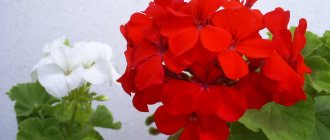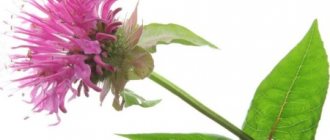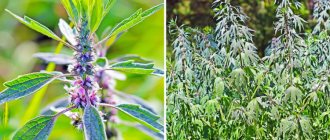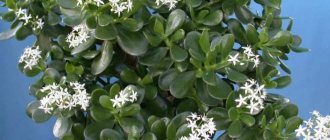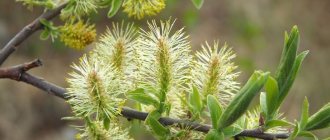Botanical description
The white water lily is one of 50 species of the genus Nymphea, named after the ancient Greek deity of nature. It looks like this:
- The rhizome is long, powerful and branched. It is dark brown in color and covered with the remains of petioles. The roots may grow in poorly ventilated soil. Adaptation to such unfavorable conditions occurs due to the fact that they are supplied with oxygen from the leaves.
- The water lily leaf is wide, flat, round or heart-shaped, without outgrowths or denticles. It can reach 30 cm in diameter; due to the presence of air cavities and the distribution of weight over a large area, it floats on water and can even support a small amphibian. Its upper surface is dark green, and its lower surface is red-violet. On the back side there are special epidermal cells that absorb water and nutrient minerals. Long flexible petioles are located deep under water. If the pond dries out, they will die off, but after a while they will germinate again on the rhizome and grow even stronger.
- A large flower from 5 to 20 cm in diameter is single, with regular symmetry and 15-30 petals. Like the leaves, it floats and emits a weak aroma. Its outer cover, formed by 3-5 green sepals, is rounded. You can see it from mid-summer to autumn.
- The snow-white petals of the flower are formed by the transition from the male reproductive organs, the stamens. There are from 75 to 110 of them. Female organs - from 14 to 20. They are called pistils. They are solitary and characterized by sessile multi-rayed flat yellow stigmas.
- The ovary fuses with other parts of the flower, and its tip remains free. After pollination, a simple capsule-type fruit is formed from it. In it, seeds develop under water from August to September. Their embryos have two embryonic leaves, so the plant belongs to the class of dicotyledons. After ripening, due to the supply of air, the seeds float to the surface.
A water lily is often mistakenly called a water lily. But this plant belongs to a different genus, and its difference from the water lily lies in the yellow color of the flower and its pleasant smell.
Description of the plant
Water lily or white water lily, one of the oldest plants. There are many beliefs and legends about its origin. Almost every people on earth has a myth, legend, tale or belief in which the white water lily would participate.
Some myths say that the flower is named after the nymphs that live in the water in which it grows.
The latter associate flowers with the image of mysterious mermaids. Still others say that this is the incarnation of an ancient Greek nymph who did not receive an answer to her love for Hercules. The ancient Greeks attached great importance to the lily, considering the water lily to be a flower of eloquence and beauty. The Indians of North America believed that the white water lily came from the collision of two stars.
Brief description of the biological features of water lily:
- Lily belongs to the water lily or nymphaeaceae family.
- Herbaceous, aquatic perennial plant.
- It is often grown for decorative purposes and used in landscape design to decorate ponds.
- The plant is considered medicinal.
- Used in cosmetology and folk medicine.
- Very photophilous.
- Grows exclusively in sunny ponds.
- Selects standing waters of lakes, ponds, river bays.
- Usually located near the coast.
- It does not develop in strong currents.
Nymphea grows almost everywhere. The main habitat is temperate and tropical zones, European countries, the European part of Russia and the South, the Northern Caucasus, Western Siberia, the South of the Far East, Asian countries, North America and Africa, the Amazon.
Habitat
Water lily is a plant that belongs to the hydatophytes, a characteristic feature of which is complete immersion in water. The thickness of the liquid supports the flower on all sides, so its tissues are characterized by the following development:
- sclerenchyma, which gives the body mechanical strength, is very simplified;
- parenchyma, consisting of multifaceted delicate cells, with poorly developed vascular-fibrous bundles forms the bulk;
- aerenchyma is an air-bearing tissue with large voids that provides gas exchange and makes it possible to reduce specific gravity; it is well developed.
This structure ensures that the water lily adapts to its habitat, but makes its stems and leaves extremely weak without the support of water, which is why they fall off when removed.
Growing water lilies
- The right period for planting water lilies is warm summer days. The plant can be immediately planted at the bottom of the reservoir.
- The planting substrate that the white water lily takes is prepared independently or purchased in the store. The optimal composition in this case is a 4-centimeter thick peat layer and a 10-centimeter thick turf layer of soil with sand.
- When planting this plant, it is important to ensure that the growth bud is on the surface of the pot, and feeding balls made of clay mixed with mineral fertilizers are stuck on the roots of the water lily.
- For the rapid development of the water lily until the leaves appear, it is better if the flower is immersed in shallow water.
Caring for water lilies in the garden
- Dead flowers and yellowed foliage should be removed from the pond. In order for the water lily to produce more flowers, it should not be left with more than two floating leaves.
- It is worth ensuring that the plant has enough space in the pond.
- Small artificial reservoirs where there is standing water must be cleaned periodically. After the water lily is removed for the winter, the reservoir is lowered and cleared of debris and dirt.
Plant in floriculture
If you have a pond or lake on your own property, you can plant a water lily there yourself. It will bloom regularly if the area of the reservoir allows for at least a square meter of space for each shoot. The surface of the water should be well lit.
Planting takes place in May or June. To do this, first prepare the soil from peat, river sand, compost and garden soil, and then attach the root to the bottom.
Caring for the plant is carried out by removing dry leaves and faded buds, as well as applying fertilizer. Bone meal is a good choice for the latter. Balls formed from it and clay are buried next to the roots. Flowers also need to be protected from aphids, due to which the buds may not open, and snails that eat the foliage.
The water lily can reproduce on its own - birds spread its seeds, as they mistake them for fish eggs. You can also cut off a piece of rhizome with a bud from the plant and plant it. Vegetative propagation will be safe for the water lily if you grease the cut with crushed charcoal.
White water lily in cooking
- The dry rhizomes of the white water lily are rich in starch; flour is obtained from them, which is mixed with wheat and baked into bread.
- Water lily seeds, roasted and ground, can replace coffee.
- Boiled rhizomes. The rhizomes are washed, cut into small pieces (3-4 cm), soaked for 5-6 hours and boiled in salted water. Peel the skin and serve with butter, sprinkled with dill.
- Fried rhizomes. The rhizomes are washed and soaked for 5-6 hours in salted water. Then peel the skin, cut into strips and fry in butter until golden brown. Serve warm, sprinkled with herbs.
Also, a decoction of the rhizome can stain the fabric black; the smell of all parts of the plant repels cockroaches.
222
Edited 05/18/2020 Comments: · Reading time: 3 min · Views: 222
Medicinal properties
A water lily can be planted in your own pond not only for aesthetic purposes, but also for very specific benefits. Its flowers and roots have a calming, antipyretic, analgesic and hypnotic effect.
To take advantage of the healing properties of the plant, you need to collect the buds early in the morning. They need to be crushed, doused with boiling water and wrapped in gauze. This way you can get an excellent pain-relieving compress.
An infusion of petals boiled for 15 minutes and infused for 4 hours can be used to wipe the skin to cleanse it. The rhizomes of the plant can reduce inflammation of the skin no less effectively. To do this, they need to be collected in early autumn, because at this time the maximum amount of nutrients accumulates in them.
The roots extracted from the bottom using hooks are cleaned of cuttings and leaves, washed, cut and dried. Then an infusion is prepared from them, like from flowers.
Some people are not afraid to use remedies from various parts of the water lily internally. But you shouldn’t do this without a doctor’s supervision, since the plant can be poisonous. Even before using folk remedies externally, you should consult a specialist.
White water lily - medicinal properties and use in folk medicine
Flowers, rhizomes and leaves are used for medicinal purposes. The leaves are collected during flowering, and the rhizomes from the moment of flowering.
The plant is unofficially sold in pharmacies, although the rhizome is included in Zdrenko’s medicine, which is taken for papillomatosis of the bladder, anacid gastritis and stomach ulcers.
- In folk medicine, white water lily is used to treat tumors.
- A decoction of the rhizome is drunk for diseases of the kidneys and bladder, as a hemostatic, astringent, and blood pressure-lowering agent. Wash your hair with a decoction to stimulate hair growth and strengthen it.
- Crushed fresh rhizomes are applied as mustard plasters for neuralgia and myositis.
- Powder from the rhizomes is sprinkled on purulent wounds or taken orally for diarrhea.
- A tincture of the leaves is used for kidney stones.
- Fresh leaves crushed into a paste are applied to inflammatory areas of the skin.
- In folk medicine, an infusion of water lily flowers treats fever, insomnia, increased nervous and sexual excitability, painful emissions, uterine bleeding, and leucorrhoea.
- A tincture of water lily petals is taken for anemia, diseases of the nervous and cardiovascular systems, and also externally, used as a rub for neuralgia, rheumatism, and radiculitis.
- Poultices from the petals relieve pain from neuralgia and myalgia.
Infusion of white water lily flower petals and blood red hawthorn flowers
2 tablespoons of a mixture of dry raw materials or 4 tablespoons of a mixture of fresh raw materials are poured with 300 ml of boiling water and left for 20 minutes. Strain and drink a tablespoon every 2 hours for heart failure.
Decoction of white water lily rhizome
A tablespoon of dry crushed raw materials is poured into 300 ml of water and brought to a boil, boiled for 10 minutes, left for 20 minutes. Strain and drink a tablespoon 3 times a day for cystitis, gastritis, jaundice, constipation.
Decoction of white water lily rhizome in beer
A tablespoon of crushed dry rhizome is poured into 1 glass of beer and boiled for 10 minutes. Leave for 30 minutes, filter. After washing your hair with baby soap, rub the decoction into the skin, repeating the procedure 3 times for 30 minutes. Each time, wrap your head in a towel, then rinse your hair with warm boiled water. The decoction is rubbed once a week for 3 months.
Interesting Facts
A story about a water lily would not be complete without interesting details about it. Among the special facts about this plant are the following:
- Frescoes and vases with pictures of water lilies were popular in Ancient Greece, Egypt and Rome, as the flower symbolized purity, chastity, greatness and beauty.
- The Slavs collected the leaves and flowers of the marsh plant to make amulets that would protect them from troubles while traveling.
- A design of a water lily can be seen on the emblem of Södermanland, as it is the symbol of this Swedish province.
- The color of water lily petals is repeated in other members of the family, for example, in the tetrahedral water lily, which is rarely pink and mostly grows white.
- The plant can predict the weather. During the day it closes when rain approaches.
- The rhizome of the water lily contains many nutrients, which include starch, proteins and sugar. This composition is of economic importance. In the Caucasus, young roots are fried or boiled and eaten. They can be dried and made into flour, and they can be used to dye fabrics in dark colors. The seeds contain tannins that can be used as a coffee substitute.
The amazing structure of the white water lily
The white water lily is a plant of extraordinary beauty. But not only the beauty of this plant is surprising, its structure is also unusual, it is not similar to any other plant.
Features of the structure of the water lily:
- The stem is straight, free-floating, round in shape, dense.
- superficial leaves are worth special attention, they are simple, the color of the upper part is always bright green, the lower part, depending on the variety, has a color from crimson to green. The leaves are round in shape and reach a diameter of 50 cm. They grow independently from the rhizome.
- The underwater leaves are simple, oblong, pointed at both ends, rolled into a capsule. Serve to protect flower buds and emerging leaf embryos. The color depends on the variety.
- The buds are large, bright, rich in color; when open, their diameter reaches 25 cm, with yellow stamens in the center. The calyx consists of 3-4 petals. Numerous petals of the bud itself are located throughout the circle of the flower. The buds open only in clear sunny weather.
- The fruit is green, ball-shaped, and ripens under water. Looks like a jug.
The roots take root well in the mud, are very thick, white or dark brown in color. The above-water part of the lily consists of large leaves of bright green color, oval or round in shape and magnificent flowers. The general appearance of a water lily depends on its variety.
Water lilies bloom from late spring until almost frost.
It is surprising that lily flowers hide under water at night and emerge at dawn. As the sun sets, the flowers open, revealing all their beauty to the world. They often float up, but do not open in cloudy weather.
Security status
Information about the water lily is listed in the Red Book, since massive pollution and drying out of water bodies leads to a reduction in the number of the species. Practical measures aimed at protecting the plant include engineering and environmental measures to protect nature. But pollution can also be combated at the household level. Every person can make a contribution, just start with rational housekeeping, for example:
- use detergents with environmentally friendly ingredients;
- properly dispose of waste, in particular, do not flush paint, cleaners and solvents down the drain;
- use water sparingly;
- limit the use of plastic.
Even a child should know these simple rules. The more people follow them, the larger the environmental situation can be changed.
Snow-white water lily
The snow-white water lily (Nymphaea candida) got its name due to the lighter color of its petals compared to the previous species.
Other differences: the base of the calyx is not round, but almost quadrangular, as well as a low stigma of orange color.
The diameter of the flowers is about 15 cm. The snow-white water lily blooms at the end of May.
Ponds and shallow lakes where the snow-white water lily grows are located in the European part of Russia, Western and Eastern Siberia, Central Asia and Kazakhstan.
Application
Planting and caring for nymphs is carried out mainly by specialists: flowers require serious care. For the winter they are moved to containers if the reservoir freezes to the bottom. Water lilies are grown for decorative and medicinal purposes everywhere. Hybrid varieties are mainly used to decorate artificial reservoirs. Snow-white water lily, as well as red nymphea and dwarf nymphea with the “rubra” variety are valued in the improvement of ponds. These water lilies have a red hue in both flowers and leaves, and contrast beautifully with the surface of the water. An interesting variety of white nymphea “alba rosea”: the pink color of the petals sets off the greenery.
Nymphea is also in demand in cooking. White nymphea species are distinguished by their large starchy rhizomes. It is used to make flour that can be used to make wonderful gluten-free bread.
Pure white water lily blossom
Flowering time depends on climatic conditions . In sunny and warm climates, the plant blooms in mid-June. If conditions are cool or it is in constant shade, flowering begins in July.
The duration of flowering also depends on the weather, and can last until October.
Snow-white water lily flower
It can be grown on your own plot by organizing a small pond. The only condition is that the artificial reservoir is of sufficient size.
Planting is carried out using rhizomes, on which the buds should be located. Placed in a special container, the root is covered with earth and gravel, then lowered to the bottom of the pond.
